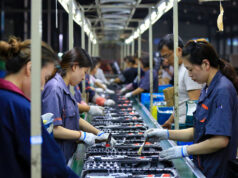Perfection in a salmon sashimi
FROM SUSHI delivered by train, we now have sushi crafted by hand.
From the same people who brought train-delivered Genki Sushi to the Philippines, we now have Sen-ryo, a more upscale sushi restaurant located in The Podium in Ortigas. It shares its origins in Japan with its sister, Genki Sushi, having been founded by the same person, Fumio Saito (also behind the idea for conveyor-belt sushi). Sen-ryo has a presence in Hong Kong, Shanghai, and, of course, its home city, Tokyo, and now Manila.
“Our partners really loved Sen-ryo in Hong Kong and Japan. They really wanted to bring it here. We do think the Philippine market is ready for premium Japanese food. They expect so much quality,” said Mia Teng, Marketing Officer for Baby Spice Food Corp. Sen-ryo is operated in the Philippines on a franchise basis by the same people behind, as mentioned, Genki Sushi, but also Mango Tree. Under this same umbrella are homegrown brands Cucina Peruvia and Kureji.
Everyone has a definite idea of what sushi is, and what it is not. Traditionally, it is a roll of rice with seafood in it, once used as a way of preserving it. Of course, cultural dialogue between the East and West has brought forth many different kinds, one being the Cheese Shrimp Cutlet Roll that BusinessWorld tasted during a dinner at Sen-ryo late last month. Filling and substantial, but not exactly what we were looking for. Cultural exchanges, however, hit a home run with a dish we favored, the Sen-ryo salad with leafy greens and a wasabi dressing — and mounds of seafood tucked under the vegetables. Raw slices of sashimi, plump slices of scallop, and many other delicious invertebrates found their way in there. That was quite something, with the lightness of the actual taste providing a perfect blend with the actual weight of the salad.
Speaking of sashimi, they served a Salmon Belly Sashimi, which was perfect. It was firm, never limp; therefore proud of its freshness. The slices were thin enough to still be called sashimi, but were of enough weight to leave one not constantly running after a taste. Despite its substance, it was light and silky and gave the sensation of melting in your mouth, staying whole only at your wish. For this alone, I would come back.
Well, there’s another reason: the Ohmi. Ohmi are slices of wagyu, a cousin to better-known Kobe and Matsusaka, but apparently, Ohmi is a much more senior cousin, its origins dating back to the 1500s. You cook it on an attractive ceramic contraption heated underneath by a lump of (what I assume to be) paraffin or some other fuel, and you cook the slices in a tiny dollop of butter, along with a few mushrooms. The secret is never overcooking the beef so you can taste the cattle in all its glory — and don’t worry, the restaurant knows that. The fuel that heats up the plate is carefully measured and runs out at the time when the slices are cooked to perfection. BusinessWorld was having too much fun to actually measure this time, but all the same, the result was tasty, and, yes, it had a perfect texture.
The recipes have been prepared by Japanese chefs straight from Japan, who are currently training the local chefs.
“It’s authentic, [but] modern Japanese,” said Ms. Teng, which might explain the salads and the cheese in the menu.
There are, however, loads, and I mean loads, of Japanese restaurants which can lay claim to some level of superiority, but why should one choose to go here?
“Everyone says they are premium,” said Ms. Teng. “It’s a very easy thing to say. But our items are specially picked just for Sen-ryo. We have our own suppliers and communications from Japan. We ship directly from there.” — Joseph L. Garcia



